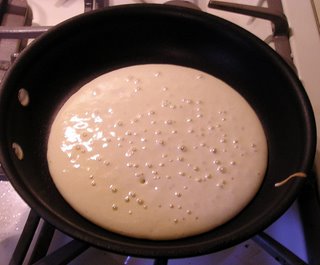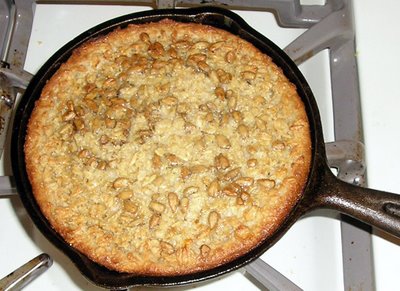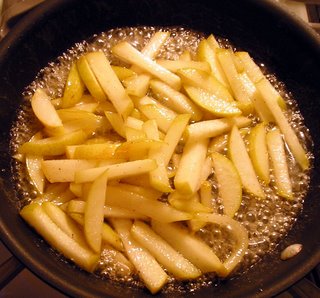Strawberry Fields, Forever

The first thing you have to understand is that it is never just about the berries. If you wanted nothing more than terrific strawberries, you would just call to reserve a few quarts and drive up to the orchard market after work one day and you'd get berries at least as good as the ones you would have picked. You'd pay more, certainly, but you wouldn't have been squatting or crawling in the damp straw, picking up stains that will never, ever come out.
Your own picking, fine though it may be, will not guarantee the perfect berry. You can be sure that they will be far better than what you get from the supermarket, but even if you pick the berry in that fleeting moment between under and overripe, there are too many factors beyond your control. Perhaps there was not enough sun this year. Perhaps the rain was first excessive and then insufficient. Perhaps they have a different variety now, but you can be about as certain as you are about anything that the berries aren't going to be quite as good as the ones from that year and that stand where you picked up a quart and bit into one and it tasted like wine, and the two of you went through the whole quart without even thinking about sugar or cream.
 Picking berries is as much about the journey as it is about the result. That is why, on a late May morning, when I checked the orchard's website (no, it's really not like it was when you were growing up; at least not that part; in those days, someone would drive by the patch and ask the farmer whether the berries were ready and then the telephones would ring, and your mother would gather you and your siblings and your pots and pans and put everything in the car and off you'd go; and in those days, you didn't have to go very far: there were good patches all over the place) and see that the season is officially underway, I decided not to take the shortest and most reliable route. I don't pick berries every year, and because of the frequency with which the rural highways in this heavily suburban county get rearranged, I can't always tell you exactly where the orchard is. I could print out directions, or I could take the way that I know will get me there even if I don't have directions, but it's about the journey, so instead I just head off in the approximate right direction, and when it feels like I've gone far enough (maybe twenty minutes; maybe more), and I see a turn that looks like it will land me closer to where I want to be, I take it, and eventually, when my desire for the fields grows strong enough, I will see in the distance, rising like Brigadoon from the mists, a row of people bent over and filling their cardboard containers with berries. Another five minutes and four or five more turns brings me to the orchard, and an additional five minutes across gravel roads brings me to the field.
Picking berries is as much about the journey as it is about the result. That is why, on a late May morning, when I checked the orchard's website (no, it's really not like it was when you were growing up; at least not that part; in those days, someone would drive by the patch and ask the farmer whether the berries were ready and then the telephones would ring, and your mother would gather you and your siblings and your pots and pans and put everything in the car and off you'd go; and in those days, you didn't have to go very far: there were good patches all over the place) and see that the season is officially underway, I decided not to take the shortest and most reliable route. I don't pick berries every year, and because of the frequency with which the rural highways in this heavily suburban county get rearranged, I can't always tell you exactly where the orchard is. I could print out directions, or I could take the way that I know will get me there even if I don't have directions, but it's about the journey, so instead I just head off in the approximate right direction, and when it feels like I've gone far enough (maybe twenty minutes; maybe more), and I see a turn that looks like it will land me closer to where I want to be, I take it, and eventually, when my desire for the fields grows strong enough, I will see in the distance, rising like Brigadoon from the mists, a row of people bent over and filling their cardboard containers with berries. Another five minutes and four or five more turns brings me to the orchard, and an additional five minutes across gravel roads brings me to the field.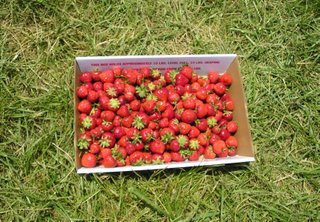 This part is the same as it was when I was growing up. People who otherwise may have very little in common all thrown together in a field doing the same thing, gathering food with their own hands. This morning, I ended up next to two people who were, I presume, in college and dating each other. At one point, the young man turned to me and said, "What are you going to do with your berries, sir?" It is with great difficulty that I hear anyone call me "sir" without laughing, but he was simply trying to be polite, and he probably couldn't help being half my age, so I told him what I had planned for my berries and inquired after his. He said that they planned to eat most of them as they were, but that they also intended to dip some in chocolate. I suggested that he might want, in that case, to consider leaving some of the stem on when he picked the berries, and he then asked me if I had some idea how to prepare the chocolate for dipping. I gave him a few pointers and told him where to find the nearest Trader Joe's to pick up some good chocolate at a reasonable price. I was gathering fewer berries than I have in past years, but the young couple was gathering fewer berries still, and there were two of them, so it was not long until they were bidding me a good day (sadly, there was another "sir"), and I was left alone with my thoughts and the berries. It was the first official day of the season, and the berries were generally neither as ripe nor as plentiful as one might hope, and the day was a good deal hotter than one might like, but certainly the only person who could watch his flat fill with red berries on a sunny day without feeling euphoric would be someone with too hard a hart to pick strawberries in the first place.
This part is the same as it was when I was growing up. People who otherwise may have very little in common all thrown together in a field doing the same thing, gathering food with their own hands. This morning, I ended up next to two people who were, I presume, in college and dating each other. At one point, the young man turned to me and said, "What are you going to do with your berries, sir?" It is with great difficulty that I hear anyone call me "sir" without laughing, but he was simply trying to be polite, and he probably couldn't help being half my age, so I told him what I had planned for my berries and inquired after his. He said that they planned to eat most of them as they were, but that they also intended to dip some in chocolate. I suggested that he might want, in that case, to consider leaving some of the stem on when he picked the berries, and he then asked me if I had some idea how to prepare the chocolate for dipping. I gave him a few pointers and told him where to find the nearest Trader Joe's to pick up some good chocolate at a reasonable price. I was gathering fewer berries than I have in past years, but the young couple was gathering fewer berries still, and there were two of them, so it was not long until they were bidding me a good day (sadly, there was another "sir"), and I was left alone with my thoughts and the berries. It was the first official day of the season, and the berries were generally neither as ripe nor as plentiful as one might hope, and the day was a good deal hotter than one might like, but certainly the only person who could watch his flat fill with red berries on a sunny day without feeling euphoric would be someone with too hard a hart to pick strawberries in the first place. The journey is important, but you do end up with a quantity of berries and the knowledge that you can only get such berries for a few weeks a year, so you had better have a plan for dealing with them. I ended up with eight pounds of good, if not transcendent, strawberries, and I took them home (via a much more direct route, which I must remember for sour cherry season, which you really will miss if you blink) and got to work. Every use of strawberries that I know begins with hulling the berries. The always-reliable (if occasionally obsessive) Alton Brown avers that none of the several implements that are sold as strawberry hullers does a good job removing the hulls from strawberries. He recommends a star pastry tip. If memory serves, he recommends a #5 star pastry tip, but without undue searching, I could find only a #6 tip. It did seem a bit large on some of the smaller berries, but it did an admirable job of removing the hulls quickly and cleanly.
The journey is important, but you do end up with a quantity of berries and the knowledge that you can only get such berries for a few weeks a year, so you had better have a plan for dealing with them. I ended up with eight pounds of good, if not transcendent, strawberries, and I took them home (via a much more direct route, which I must remember for sour cherry season, which you really will miss if you blink) and got to work. Every use of strawberries that I know begins with hulling the berries. The always-reliable (if occasionally obsessive) Alton Brown avers that none of the several implements that are sold as strawberry hullers does a good job removing the hulls from strawberries. He recommends a star pastry tip. If memory serves, he recommends a #5 star pastry tip, but without undue searching, I could find only a #6 tip. It did seem a bit large on some of the smaller berries, but it did an admirable job of removing the hulls quickly and cleanly. You could probably use up eight pounds of fresh berries, without preserving any, if you had a lot of people to feed, but I knew when I picked my berries that some of them were destined for the freezer. AB will also tell you that the best way to freeze strawberries is to use dry ice. Apparently, if you freeze whole berries (with the hulls removed) with dry ice, they will freeze solid so quickly that when they are slowly defrosted, they will retain the character of fresh berries. I'm sure that AB knows what he's talking about, but I don't do dry ice, and I've pretty much resigned myself to the fact that thawed strawberries are about flavor, not texture. So for about a quarter of my berries, I cut them into quarters, sprinkled them with sugar, let them macerate for a few hours in the refrigerator until they were very juicy, then I packed them into containers, covered the containers with plastic wrap, put on the lids, and plopped them into the freezer.
About half the berries are now being stored in the refrigerator. I used the clamshell container that the last strawberries I bought at Costco came in. I washed it and dried it first. I will probably make a pie Tuesday or Wednesday evening.
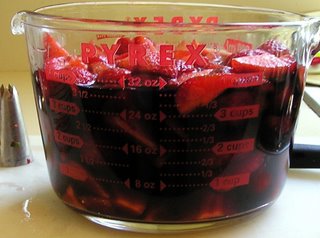 Another bunch of the strawberries got combined with red wine, sugar, and a little rosewater and made into a sorbet. Combining strawberries with red wine is another AB idea, but the sorbet is my recipe. You will have to understand that quantities are approximate. The amount of sugar you need depends entirely on the sweetness of your berries. My berries were a touch on the tart side, and I had to use a fair amount of sugar. I think that it is important to taste for sugar when the berry mixture is nice and cold. Your immersion blender will dissolve the sugar for you, even in cold liquid. The red wine you use is, of course, up to you, but something not too heavy is called for. When I conceived the recipe, I thought that a Chianti would be a good choice, and there happened to be a recently opened bottle of Chianti in the dining room, so I took some of that. I got my quantities of berries and wine by first slicing the berries into a four-cup measure and then adding wine up to the four-cup mark, but I'm certain that it was within a tablespoon or two of one-and-a-half cups.
Another bunch of the strawberries got combined with red wine, sugar, and a little rosewater and made into a sorbet. Combining strawberries with red wine is another AB idea, but the sorbet is my recipe. You will have to understand that quantities are approximate. The amount of sugar you need depends entirely on the sweetness of your berries. My berries were a touch on the tart side, and I had to use a fair amount of sugar. I think that it is important to taste for sugar when the berry mixture is nice and cold. Your immersion blender will dissolve the sugar for you, even in cold liquid. The red wine you use is, of course, up to you, but something not too heavy is called for. When I conceived the recipe, I thought that a Chianti would be a good choice, and there happened to be a recently opened bottle of Chianti in the dining room, so I took some of that. I got my quantities of berries and wine by first slicing the berries into a four-cup measure and then adding wine up to the four-cup mark, but I'm certain that it was within a tablespoon or two of one-and-a-half cups. Strawberry Sorbet
Strawberries, about one quart
1.5 cups red wine
Sugar
1 t. rosewater
Give your strawberries a brief rinse, then set them on paper towels to dry. Remove the hulls, and cut them into quarters (cut tiny ones in half; huge ones in eighths) and put them in a bowl. Pour the wine over the berries. Add half a cup of sugar, stir, and refrigerate for at least two hours.
With your immersion blender, puree the strawberry mixture. Taste it carefully and add as much sugar as you feel you need. Add the rosewater, stir well, and return to the refrigerator.
When the mixture is very cold, freeze it in your ice cream maker, following the manufacturer's directions. When done, pack it into a container, cover well, and freeze until solid.
 I have never been a whiz with the ice cream machine. I understand that you are only freezing your ice cream or sorbet most of the way and then your regular freezer does the rest, but I am never sure how far to go. With this mixture in particular, I suspect that when I go back to the freezer, I will find it fairly solid, and I may have to scrape up the portions, like an Italian ice. [Late update: twenty-four hours later, the sorbet remains very scoopable. It tastes nicer, though, if you let it sit for a bit after you scoop it so that it is just starting to melt.] You could, of course, serve it as a slushie. I tasted the sorbet right after I turned the ice cream machine off, and it was all I could do to consign it to the freezer rather than eating it all on the spot. Seriously delicious: I do not think that a better strawberry sorbet recipe exists.
I have never been a whiz with the ice cream machine. I understand that you are only freezing your ice cream or sorbet most of the way and then your regular freezer does the rest, but I am never sure how far to go. With this mixture in particular, I suspect that when I go back to the freezer, I will find it fairly solid, and I may have to scrape up the portions, like an Italian ice. [Late update: twenty-four hours later, the sorbet remains very scoopable. It tastes nicer, though, if you let it sit for a bit after you scoop it so that it is just starting to melt.] You could, of course, serve it as a slushie. I tasted the sorbet right after I turned the ice cream machine off, and it was all I could do to consign it to the freezer rather than eating it all on the spot. Seriously delicious: I do not think that a better strawberry sorbet recipe exists. You might say, with some reason, that the sorbet could be made equally well with frozen strawberries. Frozen strawberries generally are, after all, frozen at the peak of ripeness. I hope that you're right about that, because it pains me to think that I could make this recipe for only three weeks during the year. I'm sure that I'll try it with thawed frozen berries at some point in the future.



